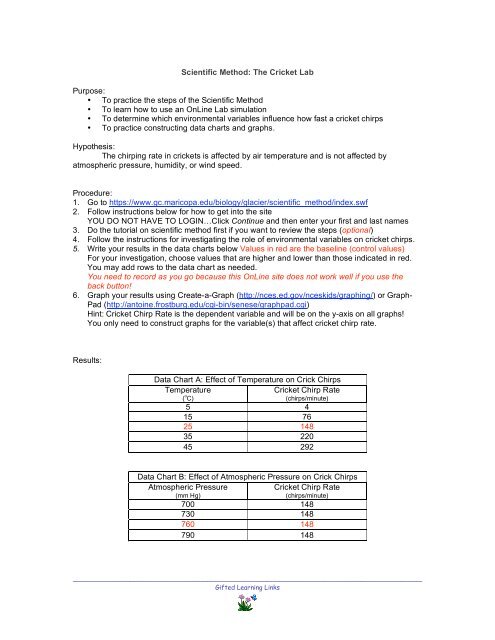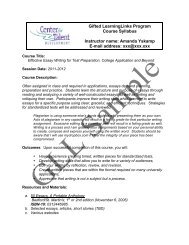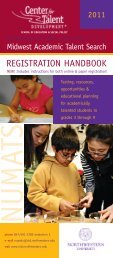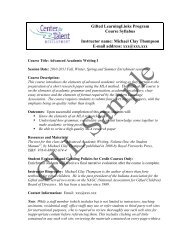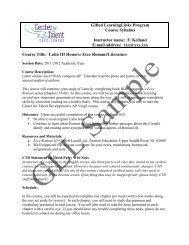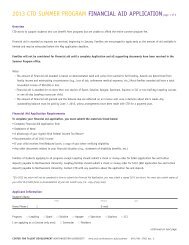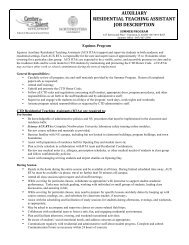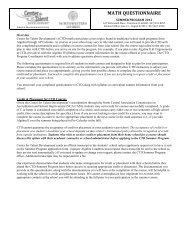Scientific Method: The Cricket Lab Purpose: • To practice the steps ...
Scientific Method: The Cricket Lab Purpose: • To practice the steps ...
Scientific Method: The Cricket Lab Purpose: • To practice the steps ...
You also want an ePaper? Increase the reach of your titles
YUMPU automatically turns print PDFs into web optimized ePapers that Google loves.
<strong>Scientific</strong> <strong>Method</strong>: <strong>The</strong> <strong>Cricket</strong> <strong>Lab</strong><strong>Purpose</strong>:• <strong>To</strong> <strong>practice</strong> <strong>the</strong> <strong>steps</strong> of <strong>the</strong> <strong>Scientific</strong> <strong>Method</strong>• <strong>To</strong> learn how to use an OnLine <strong>Lab</strong> simulation• <strong>To</strong> determine which environmental variables influence how fast a cricket chirps• <strong>To</strong> <strong>practice</strong> constructing data charts and graphs.Hypo<strong>the</strong>sis:<strong>The</strong> chirping rate in crickets is affected by air temperature and is not affected byatmospheric pressure, humidity, or wind speed.Procedure:1. Go to https://www.gc.maricopa.edu/biology/glacier/scientific_method/index.swf2. Follow instructions below for how to get into <strong>the</strong> siteYOU DO NOT HAVE TO LOGIN…Click Continue and <strong>the</strong>n enter your first and last names3. Do <strong>the</strong> tutorial on scientific method first if you want to review <strong>the</strong> <strong>steps</strong> (optional)4. Follow <strong>the</strong> instructions for investigating <strong>the</strong> role of environmental variables on cricket chirps.5. Write your results in <strong>the</strong> data charts below Values in red are <strong>the</strong> baseline (control values)For your investigation, choose values that are higher and lower than those indicated in red.You may add rows to <strong>the</strong> data chart as needed.You need to record as you go because this OnLine site does not work well if you use <strong>the</strong>back button!6. Graph your results using Create-a-Graph (http://nces.ed.gov/nceskids/graphing/) or Graph-Pad (http://antoine.frostburg.edu/cgi-bin/senese/graphpad.cgi)Hint: <strong>Cricket</strong> Chirp Rate is <strong>the</strong> dependent variable and will be on <strong>the</strong> y-axis on all graphs!You only need to construct graphs for <strong>the</strong> variable(s) that affect cricket chirp rate.Results:Data Chart A: Effect of Temperature on Crick ChirpsTemperature( o C)<strong>Cricket</strong> Chirp Rate(chirps/minute)5 415 7625 14835 22045 292Data Chart B: Effect of Atmospheric Pressure on Crick ChirpsAtmospheric Pressure(mm Hg)<strong>Cricket</strong> Chirp Rate(chirps/minute)700 148730 148760 148790 148______________________________________________________________________________________Gifted Learning Links
Data Chart C: Effect of Humidity on Crick ChirpsHumidity(%)<strong>Cricket</strong> Chirp Rate(chirps/minute)10 14815 14820 14825 14830 14835 14840 14845 14850 14855 148Data Chart D: Effect of Wind Speed on Crick ChirpsWind Speed<strong>Cricket</strong> Chirp Rate(m/sec)(chirps/minute)0 1482 1484 1486 148______________________________________________________________________________________Gifted Learning Links
Discussion:First, it was observed that one cricket in <strong>the</strong> White Tank Mountains chirped at differentrates on different occasions. Later, <strong>the</strong> cricket was caught and taken to a laboratory in order todetermine whe<strong>the</strong>r a single factor affects <strong>the</strong> chirping rate in crickets. Information from referencebooks and articles was collected. A hypo<strong>the</strong>sis was formulated and four experiments were run totest <strong>the</strong> effect of air temperature, atmospheric pressure, humidity, and wind speed on <strong>the</strong> cricket’schirping rate. <strong>The</strong> laboratory conditions were set up to recreate <strong>the</strong> field conditions in <strong>the</strong> WhiteTank Mountains. For each experiment, at least two trials were conducted by raising and lowering<strong>the</strong> independent variable in comparison to <strong>the</strong> standard and recording <strong>the</strong> chirping rate of <strong>the</strong>cricket in number of chirps per minute over ten runs. All variables but <strong>the</strong> independent variablewere controlled for each experiment. By comparing <strong>the</strong> chirping rate of <strong>the</strong> cricket for differenttrials in an experiment, conclusions were drawn. Of <strong>the</strong> variables tested, only air temperatureaffects <strong>the</strong> chirping rate of crickets, and temperature and chirping rate are directly related withchirping rate increasing more than sevenfold in chirps per minute for each degree Celsiusincrease in temperature.<strong>The</strong> experiment supported <strong>the</strong> hypo<strong>the</strong>sis that air temperature would affect <strong>the</strong> chirpingrate of crickets while atmospheric pressure, humidity, and wind speed would not. <strong>The</strong> purpose of<strong>the</strong> experiment was fulfilled through <strong>practice</strong> with <strong>the</strong> online simulation and graphing programs.Since <strong>the</strong> experiment was completed online, <strong>the</strong>re were few to no sources of error. <strong>The</strong> chirpingrate was measured over ten runs to improve accuracy, and <strong>the</strong> chirping rate ei<strong>the</strong>r remainedexactly <strong>the</strong> same or changed substantially in response to <strong>the</strong> independent variable. Thus, it wasobvious when an independent variable did or did not have an effect. In real life, <strong>the</strong> independentvariable could change during <strong>the</strong> measuring of <strong>the</strong> chirping rate and could lead to error.Additionally, it might be difficult to count <strong>the</strong> cricket chirps at high rates and to control <strong>the</strong> o<strong>the</strong>rvariables.In this experiment, one cricket was used to make a generalization about all cricketsthrough inductive reasoning. <strong>The</strong> experiment would be more meaningful if many crickets wereused. <strong>The</strong> crickets would all need to be male since female crickets do not chirp. O<strong>the</strong>rwise, <strong>the</strong>experimental design was sound.Conclusion:Air temperature directly affects <strong>the</strong> chirping rate of crickets.Reflection:I thought that <strong>the</strong> temperature would affect <strong>the</strong> chirping rate of <strong>the</strong> crickets becausetemperature affected <strong>the</strong> respiration rate of goldfish during a physiology experiment in APBiology. However, I was not sure that none of <strong>the</strong> o<strong>the</strong>r variables would have an effect. <strong>The</strong>chirping rate of crickets seems quite easy to determine since chirps can be perceived withoutdifficulty even if <strong>the</strong> cricket moves.______________________________________________________________________________________Gifted Learning Links


